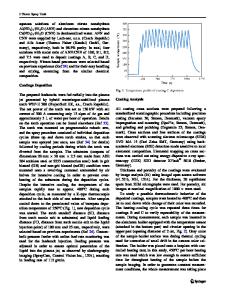Modeling of Precipitate Formation in Solution Precursor Droplets in a Microwave Plasma
- PDF / 616,196 Bytes
- 15 Pages / 593.972 x 792 pts Page_size
- 109 Downloads / 298 Views
Kaushik Saha and Baki M. Cetegen (Submitted April 7, 2011; in revised form November 11, 2011) A comprehensive computational model based on finite difference method was developed to study the heat and mass transport within solution precursor droplets injected into a laminar microwave air plasma flow field. Plasma flow field was simulated as hot gas flowing in a quartz tube generated by volumetric heat addition in the microwave coupling region. The resulting air plasma had a maximum temperature of 6000 K. Droplets containing zirconium acetate precursor of different diameters and solute concentrations were injected into the axisymmetric laminar plasma flow along the centerline of the plasma. Variation of transport properties of the plasma surrounding spherical droplets and absorption of microwave radiation within these droplets were considered in the model. Model predictions suggest that solution droplets are not affected by the microwave radiation in the presence of high convective heat flux from microwave plasma. Smaller droplets and high solute concentrations result in formation of thicker precipitate shells around them based on the homogeneous precipitation hypothesis. Mass transport is found to be slower than heat transfer in the droplets. Microwave plasma allowing the possibility of injecting droplets axially into the high temperature plasma environment present the opportunity to produce more consistent precipitate states as compared to DC arc plasmas into which droplets are typically injected transversely in thermal spray applications.
Keywords
droplet evaporation, microwave plasma, precipitation, precursor droplets
1. Introduction Ceramic and metallic coatings are routinely deposited by thermal spray processes in many manufacturing industries. For example, thermal barrier coatings (TBCs) are applied on gas turbine blades for thermal protection from hot combustion gases. Anticorrosive, thermal shock and wear resistant coatings are employed for protection of many hardware components. Thermal spray has been one of the most common processes for coating application and in this process powder material is typically injected externally into a DC arc plasma jet. Depending on the momentum ratio of the plasma and particle streams, the particles are either partially or fully entrained into the plasma jet. Entrained particles are heated and melted before they impact on a substrate (Ref 1). Turbulent dispersion in a plasma jet and factors like electrode erosion and arc root fluctuations lead to considerable degree of Kaushik Saha, Mechanical Engineering Department, University of Connecticut, Storrs, CT 06269-3139; and University of Waterloo, 200 University Avenue West, Waterloo, ON N2L 3G1, Canada; and Baki M. Cetegen, Mechanical Engineering Department, University of Connecticut, Storrs, CT 06269-3139, USA. Contact e-mail: [email protected].
Journal of Thermal Spray Technology
variations of the particle states (velocity, temperature, melt state, evaporation etc.) resulting in an inhomogeneous coating microstructure
Data Loading...











